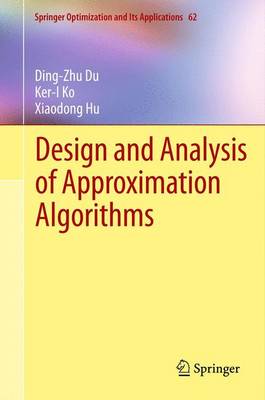Springer Optimization and Its Applications
4 primary works
Book 62
Design and Analysis of Approximation Algorithms
by Ding-zhu Du, Ker-I Ko, and Xiaodong Hu
Book 77
Connected Dominating Set: Theory and Applications
by Ding-zhu Du and Peng-Jun Wan
Book 162
Optimal Coverage in Wireless Sensor Networks
by Weili Wu, Zhao Zhang, Wonjun Lee, and Ding-zhu Du
This book will serve as a reference, presenting state-of-the-art research on theoretical aspects of optimal sensor coverage problems. Readers will find it a useful tool for furthering developments on theory and applications of optimal coverage; much of the content can serve as material for advanced topics courses at the graduate level. The book is well versed with the hottest research topics such as Lifetime of Coverage, Weighted Sensor Cover, k-Coverage, Heterogeneous Sensors, Barrier, Sweep and Partial Coverage, Mobile Sensors, Camera Sensors and Energy-Harvesting Sensors, and more. Topics are introduced in a natural order from simple covers to connected covers, to the lifetime problem. Later, the book begins revisiting earlier problems ranging from the introduction of weights to coverage by k sensors and partial coverage, and from sensor heterogeneity to novel problems such as the barrier coverage problem. The book ends with coverage of mobile sensors, camera sensors, energy-harvesting sensors, underwater sensors, and crowdsensing.
Book 196
Introduction to Combinatorial Optimization
by Ding-zhu Du, Panos M. Pardalos, Xiaodong Hu, and Weili Wu
Introductory courses in combinatorial optimization are popular at the upper undergraduate/graduate levels in computer science, industrial engineering, and business management/OR, owed to its wide applications in these fields. There are several published textbooks that treat this course and the authors have used many of them in their own teaching experiences. This present text fills a gap and is organized with a stress on methodology and relevant content, providing a step-by-step approach for the student to become proficient in solving combinatorial optimization problems. Applications and problems are considered via recent technology developments including wireless communication, cloud computing, social networks, and machine learning, to name several, and the reader is led to the frontiers of combinatorial optimization. Each chapter presents common problems, such as minimum spanning tree, shortest path, maximum matching, network flow, set-cover, as well as key algorithms, such as greedy algorithm, dynamic programming, augmenting path, and divide-and-conquer. Historical notes, ample exercises in every chapter, strategically placed graphics, and an extensive bibliography are amongst the gems of this textbook.



